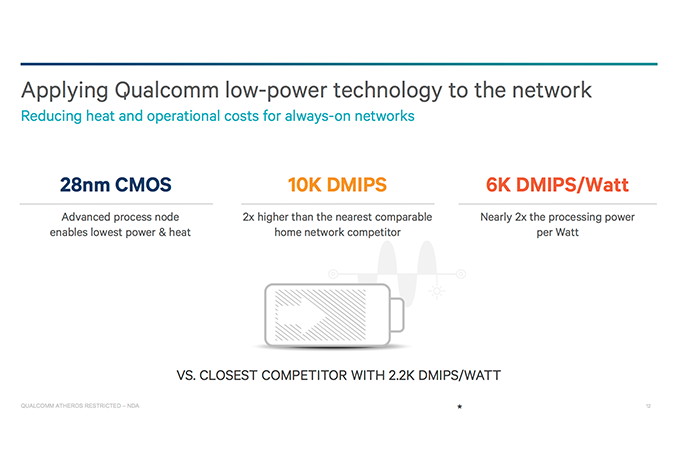Qualcomm Atheros Announces New Internet Processor Category - IPQ8064 and IPQ8062
by Brian Klug on November 20, 2013 7:30 AM EST- Posted in
- Smartphones
- Qualcomm
- Mobile
- Tablets
- Qualcomm Atheros
- IPQ8064
- IPQ8062

Today Qualcomm Atheros is announcing two new products and an entirely new category on its roadmap, the Internet Processor, prefixed IPQ (Internet Processor Qualcomm). The two new SoCs are IPQ8064 and IPQ8062, close cousins of the APQ8064 (Snapdragon 600) silicon we're become very familiar with. The lineup is targeted at high performance headless networking devices like home gateways, routers, and media servers that are part of a smart home network. With regular consumers adding more devices to their personal ecosystem, demanding more throughput and higher performance, the idea for Qualcomm is to use some of their IP and silicon in networking products as well.
In comes IPQ8064, which has 2 Krait 300 CPUs clocked at up to 1.4 GHz, two network accelerator engines clocked at up to 730 MHz, capable of processing up to 5 Gbps of aggregate throughput through the SoC all built on TSMC's 28nm LP process. There's a host of I/O in IPQ8064 as well, 3 PCIe 1x lanes, one SATA3 port, 2 USB 3.0 ports, and XGMII (10 Gbps media independent interface). There's also the same PCDDR3 1066 interface we saw with Snapdragon 600 for memory. IPQ8062 is a cut down variant of IPQ8062 with less performance and fewer interfaces, though I'm not clear on the exact differences.
Update: Both IPQ8064 and IPQ8062 have 2 Krait CPUs and the dual core packet processor engine, the difference is clocks and aggregate throughput. 8064 clocks its Kraits at 1.4GHz (ultimately for 5 Gbps) and 8062 runs its Kraits at 1.0GHz (ultimately for 3 Gbps).
IPQ8064 has been sampling for four months, and Qualcomm Atheros expects products to arrive with it inside in the first half of 2014.











20 Comments
View All Comments
pattycake0147 - Wednesday, November 20, 2013 - link
I believe that, "IPQ8062 is a cut down variant of IPQ8062" should say " IPQ8062 is a cut down variant of IPQ8064" at the end of the article.iwod - Wednesday, November 20, 2013 - link
Basically reusing everything they have in Snapdragon, except for the Mobile Network Baseband and GPU. Add in some Network Procrssors and aim squarely at Broadcom?It would be a great chip if they could just add 1 or 2 more SATA3 Port.
errorr - Wednesday, November 20, 2013 - link
It may cost more but it still has the PCI lanes for a SATA controller.A5 - Wednesday, November 20, 2013 - link
I'm much more interested in the Snapdragon 805 they just announced. I assume a separate article is coming on that?soccerballtux - Wednesday, November 20, 2013 - link
yes but what about the Nexus 5?julandorid - Wednesday, November 20, 2013 - link
Nexus is too good to be even considered for review ;)amdwilliam1985 - Tuesday, November 26, 2013 - link
Same here, still waiting for Brian's Nexus 5 review, even though I've already ordered and got my Nexus 5 Hong Kong(international) edition :) I've ordered it as soon as it's available in HK, use free shipping and received the phone within 4 days :)Gregidon1 - Wednesday, November 20, 2013 - link
Ho-boy, big numbers look impressive don't they. Since there are roughly 122M households in the US, $1B of electricity is only, on average, $8.20 a year per household. The average household spends $1150 a year in electricity, which means that this giant number accounts for only 0.7% of the average household's electrical usage. In short, network consumption doesn't really matter to the average household (also, NYC, while it may sound impressive uses less energy per capita than any other place in the US).willis936 - Wednesday, November 20, 2013 - link
Where I see the real use in these products would be the additional horsepower slapped into networking. Typically consumer routers are not very powerful and are just a glorified NAT, switch, and wifi access point. As soon as you start doing filtering or routing they hit a performance wall quickly. This is an even bigger issue when you have gigabit ethernet and soon to be multi-gigabit point to point wireless.easp - Wednesday, November 20, 2013 - link
Energy consumption on this scale might be a trivial amount for most households, but it clearly isn't trivial in aggregate. So why be so dismissive? This is a nice fast SoC for its intended application space that also, apparently, uses less power. Is that a problem?